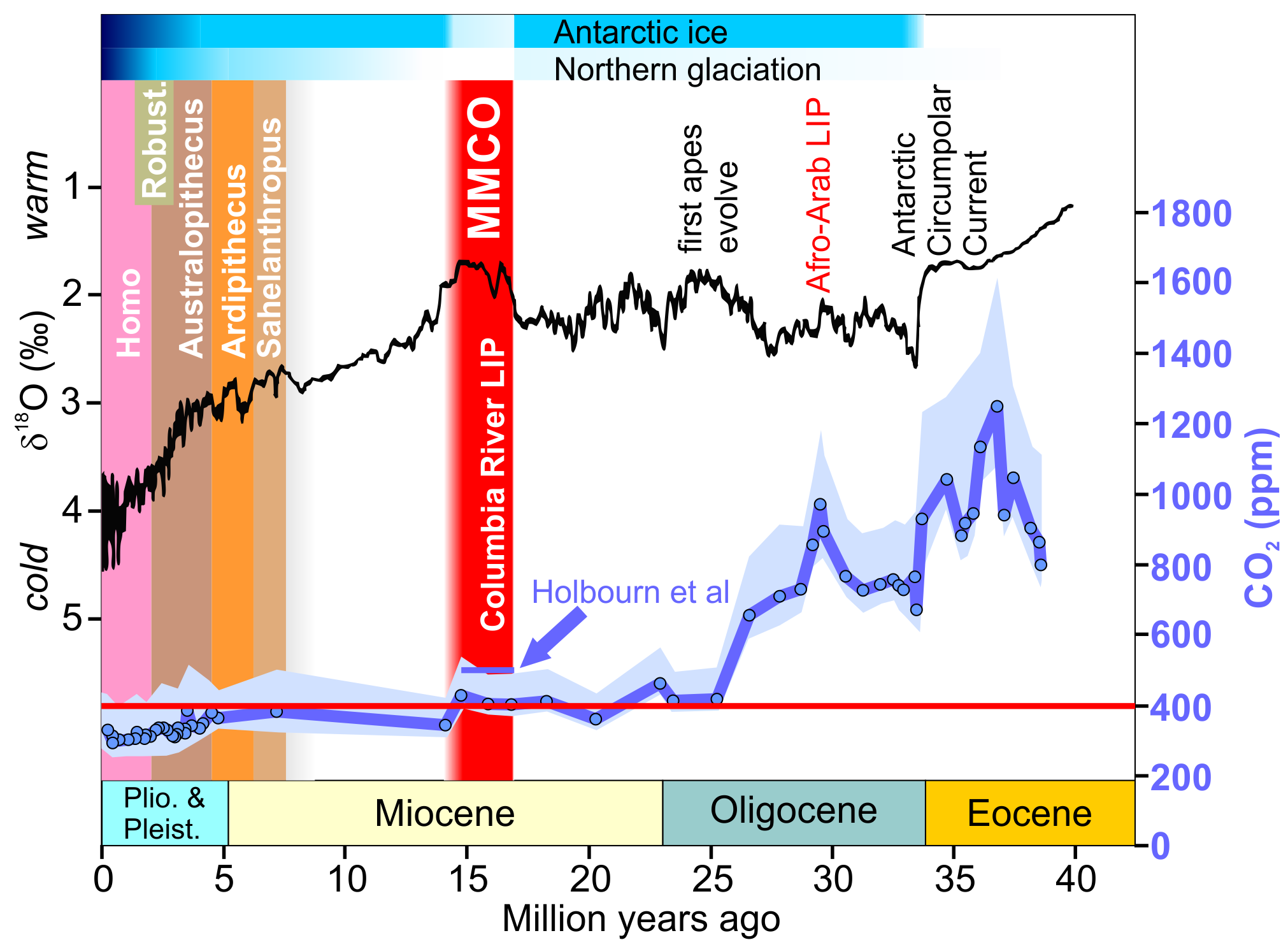
Past climate changes are analogs, albeit imperfect ones, for our modern climate change. Despite the differences between such episodes and today, they tell us a great deal about how the Earth-atmosphere-ocean-ice-vegetation-climate system responds to perturbations of the carbon cycle. Global warming in the Miocene at 16.9 million years ago is a mild example.
As we cross the 400ppm line in modern atmospheric CO2, we are entering climate territory not encountered for millions of years. We have to go back long before our ancestors evolved from apes – to the Miocene – to find CO2 at 21st Century levels.
For the duration of our genus (Homo) up to the industrial era, CO2 levels oscillated between around 180 and 280 ppm through the glacial-interglacial cycles of the ice ages. Before then in the Pliocene, as our Australopithecus ancestors like “Lucy” proliferated in Africa, CO2 was around 360-400ppm and global temperatures were on average about 3°C degrees warmer (but the Arctic was 7-8°C warmer) than today. Going further back into the Miocene, tropical sea surface temperatures were as much as 12°C warmer at 12 million years ago, with CO2 levels similar to today, estimated at around 400ppm. Ice was minimal in high northern latitudes and ice was restricted to inland portions of East Antarctica, while the rest of the continent supported temperate forests.
The Earth was on a multi-million-year cooling trend through the Miocene and Pliocene, which was slow enough to allow the feedbacks in Earth’s climate system to remain in equilibrium. But at 16.9 million years ago the Earth hit a bump in that cooling trend, an abrupt episode of global warming that was in some ways comparable to our own. This major perturbation of the Earth’s carbon cycle generated a 3-million-year-long greenhouse era known as the “Mid Miocene Climate Optimum” – mercifully shortened to MMCO.

CO2 levels for the last 40 million years over genus-level human evolution and other key events. δ18O is a proxy for both temperature and ice volume. "Robust." represents Robust Australopithecus/Paranthropus. Ape-human split is circa 7 million years ago from genetic data. Earliest ape date based on Rukwapithecus. LIP= Large Igneous Province. MMCO= Mid Miocene Climate Optimum. Arrow indicates CO2 rise to 500ppm in text of Holbourn et al. CO2 and δ18O redrawn from Zhang et al 2013. MMCO from Holbourn et al. Ice simplified from De Schepper et al 2014.
The MMCO was ushered in by CO2 levels jumping abruptly from around 400ppm to 500ppm, with global temperatures warming by about 4°C and sea levels rising about 40m (130 feet) as the Antarctic ice sheet declined substantially and suddenly.
Over the succeeding 2-3 million years Antarctic ice fluctuated dynamically in response to orbital wobbles, showing it was balanced on a knife-edge between a world with little ice and a world with substantial ice caps. Ice-free parts of Antarctica were rain-drenched and supported lush vegetation, while Arctic land was covered by temperate forests. Parts of the planet that had been arid before the MMCO rapidly re-greened and reforested (eg Patagonia).
The Miocene, in common with other warm eras in Earth’s past, had a much gentler drop off in temperatures between the equator and the poles – the so-called “equable climate” – than we have now, or have had throughout the era of Homo. In other words, the climate was disproportionately warmer at high latitudes compared to Earth’s recent past.
Until recently climate models were unable to recreate this. If they got the high latitude temperatures right the models made the tropics far too hot – by at least 10°C! If they got the tropics right the models showed the poles frozen. But that has changed with the latest generation of climate models, and how they handle climate is instructive about the world we are creating for ourselves today.
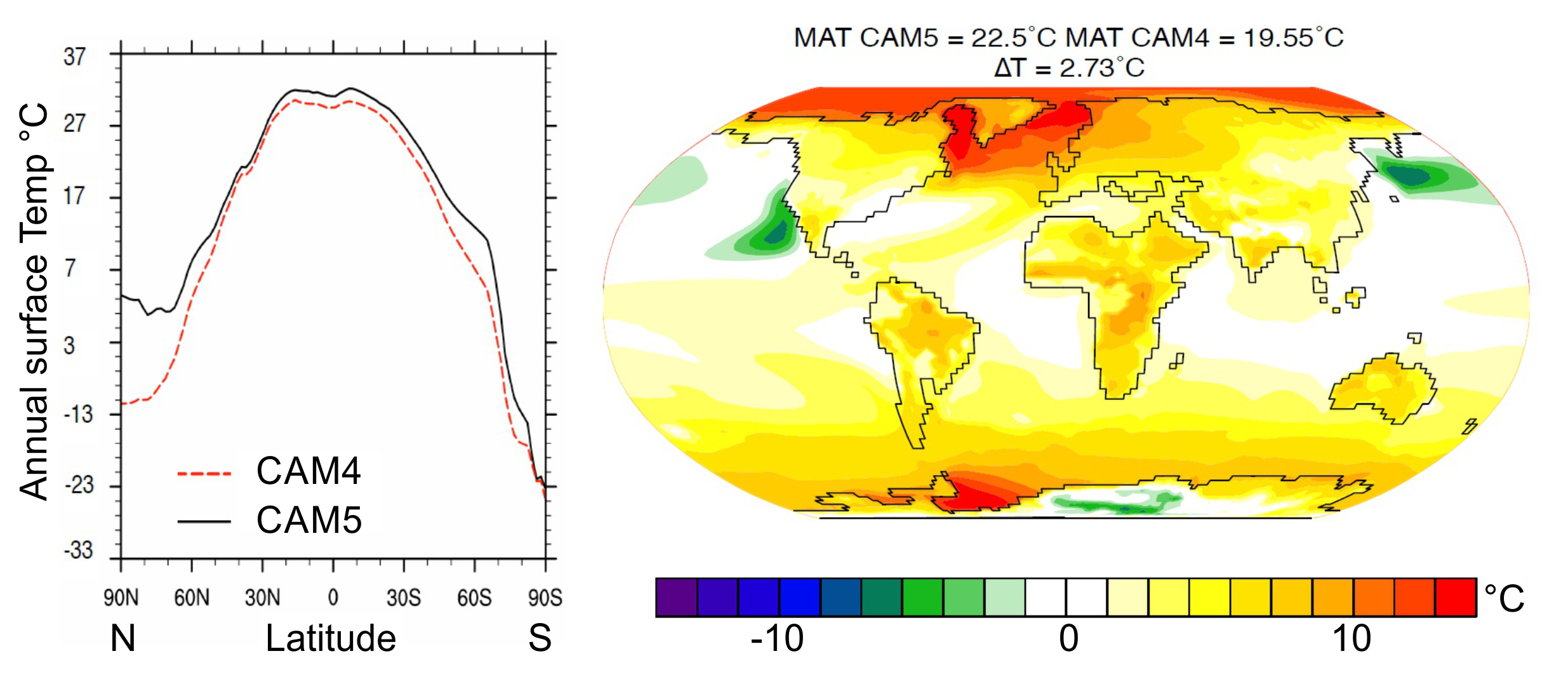
Improvements by newer models in reproducing the Miocene warm climate. Left: temperature slice from North to South poles showing how newer models better reproduce amplified Arctic warmth. Right: Map of differences between new and old models, showing the polar amplification captured by newer models. Source: Goldner, Herold, Komurcu, and Huber Poster for AGU 2014 “Exploring Sensitivity of Carbon Dioxide Forcing When Modeling the Mid-Miocene Climatic Optimum in CAM4 and CAM5” (Author’s note: preliminary, work in progress).
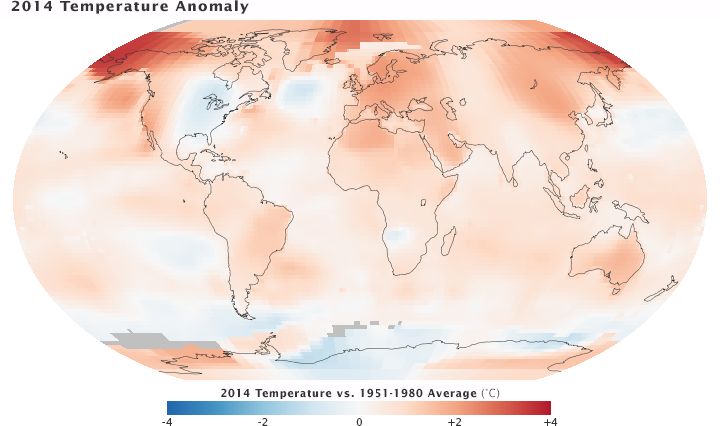
Nasa 2014 Temperature anomaly map showing Miocene-like polar amplification in the Arctic. Image Credit: NASA/GSFC/Earth Observatory, NASA/GISS
The new Community Atmosphere Model (CAM5) from the National Center for Atmospheric Research (NCAR) is more sensitive to CO2 forcing than its predecessor (sensitivity of 4°C vs 3.2°C) The new model results in average global temperatures 2.73°C warmer than the old model for the same Miocene CO2 levels. It also handles clouds more realistically, showing how clouds likely have a role in amplifying high latitude warming in greenhouse eras. This lends support for a theory outlined by Abbot et al in 2009 that in warm “equable” climates the Arctic was blanketed by clouds in winter (picture horizon-to-horizon grey skies that most UK readers will be familiar with), which trapped warmth, keeping the Arctic largely ice-free. The overall long-term effect was for the poles to be disproportionately warmer compared to global average temperatures than they have been in our recent past.
With modern climate change we already see significant Miocene-like amplifying of warming in the Arctic (see the figure above). Miocene sensitivity to CO2 may not have been exactly the same as the sensitivity today because the Isthmus of Panama was not yet closed, currents between the Pacific and the Indian Oceans were different, there was substantially less ice, and land cover had no buildings or agriculture (to mention a few differences). Moreover, as as outlined above, models suggest even the cloud distribution was different. For these reasons some have suggested that the steady-state cooling late Miocene was 0.5-0.8°C more sensitive to CO2 than today. Even allowing for that, the fact that models need a sensitivity of 4°C per CO2 doubling to recreate Mid-Miocene warmth suggests that the modern value is more likely towards the upper end of the IPCC range of 1.5-4.5°C than the lower end. For more on the IPCC’s sensitivity value see this post by John Fasullo last year.
But those sensitivity values are for a climate in equilibrium, whereas the MMCO onset, like today, was not in equilibrium.
Like today, the MMCO global warming was driven by large and rapid (geologically-speaking) CO2 emissions.
A new paper in “Geology” by Holbourn et al expands on evidence presented at the 2014 AGU Fall Meeting of a major perturbation of the global carbon cycle that is synchronous with the abrupt warming 16.9 million years ago.
How abrupt? That was a question I put to Ann Holbourn after her AGU presentation. She explained that it is still not possible to be precise about the speed of the event, but tentatively it may have unfolded over “a few thousand years.” That’s faster than the slow feedbacks of the Earth system, which puts the climate system out of equilibrium and allows a build-up of atmospheric CO2 accompanied by abrupt global warming. Much like today.
In another sign that the event involved a large load of atmospheric CO2, the oceans experienced a massive increase in carbonate dissolution – a carbonate saturation crisis – that indicates ocean acidification. Much like today. The level in the ocean below which shells and limestone dissolves (the Carbonate Compensation Depth) shoaled for some 80,000 years, yo-yoing up and down by up to 600 meters, implying that there were “massive switches in ocean heat transfer, ice volume, and carbon cycling over relatively short time scales (on the order of a few thousand years)” – a further sign of that knife-edge climate teetering between a world of little ice and a world of large ice caps, like today.
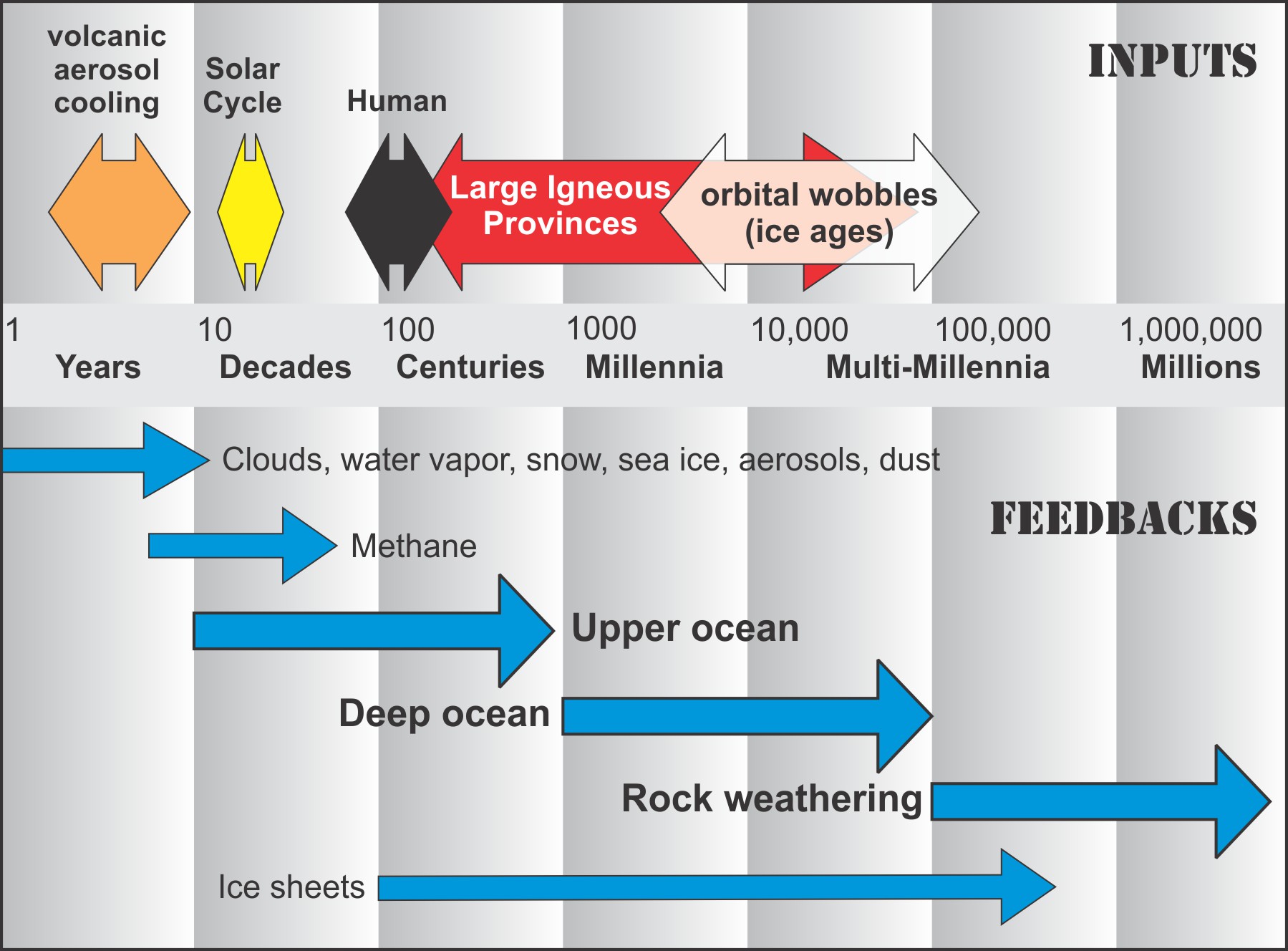
Different parts of the climate system respond at different rates. Based on Schmidt, 2012 & Zeebe, 2012.
The CO2 that triggered the MMCO was emitted by the spectacular eruptions of the Columbia River Basalts across a large area of western America. These eruptions were of a scale that dwarfs any in recorded history, and any in the last 16 million years. In the most intense phase, more than 150,000 cubic kilometers (36,000 cubic miles) of lava gushed over a large part of western America in roughly 300,000 years (some have suggested as little as 10,000 years, a timescale that is in the ballpark of that suggested by Ann Holbourn). In many of the hundreds of individual eruptions, lava vomited from the bowels of the earth in mile-high (1.5km) fountains before deluging 500km (300 miles) of landscape in months, to a depth of 100 meters (300 feet), while ash and fumes mushroomed as high as the stratosphere.
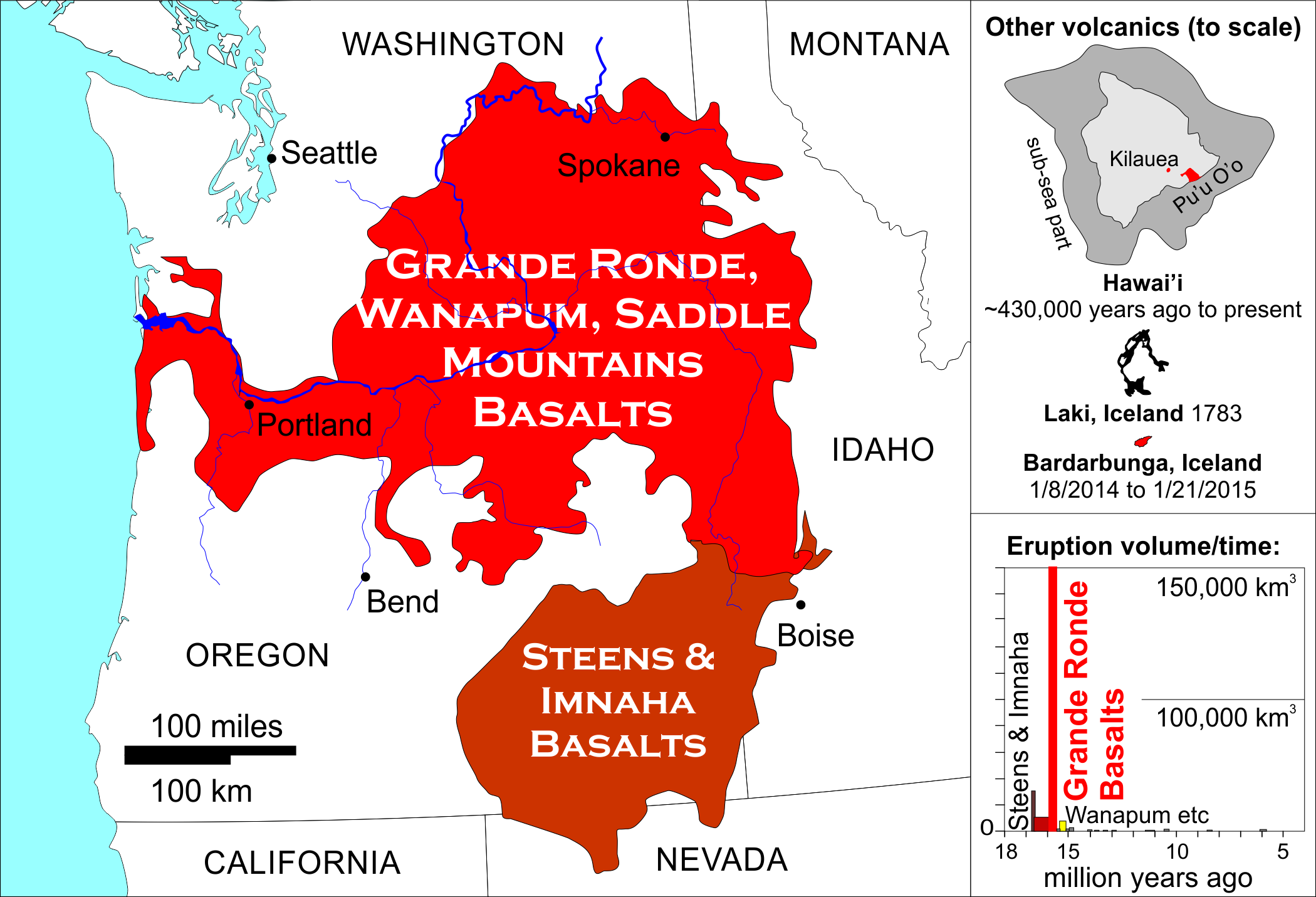
The extent, timing and volume of the Columbia River Basalt eruptions compared to Hawai’i, Laki and the ongoing Bardarabunga eruption. Based partly on Self 1997 in Ernst 2014 “Large Igneous Provinces” (Cambridge University Press) and Self et al 2014.
Individual volcanic eruptions typically emit trivially small quantities of CO2 compared to the background level in the atmosphere. But the huge scale of the Columbia River Basalt eruptions emitted atmospherically-significant quantities of CO2 both directly and indirectly from magma-filled fissures (“dykes”) that baked CO2 out of the rocks around them.
Quantifying those CO2 emissions, however, has proved difficult. One recent paper considered a range of possibilities from 230 to 6,200 Gt of carbon (compared to about 500 Gt emitted by humans to date, projected to be 1,500 to over 2,000 Gt by the end of the century). Our modern emissions are small compared to the high-end of those estimates but – and this is crucial – packed into a far, far shorter time frame. Even the most intense phase of eruptions took 1,000 times longer than the entire industrial era.
But those CO2 estimates assumed a steady release of CO2 between the oldest and youngest eruptions, whereas geological evidence shows the eruptions occurred in a series of intense pulses. Modeling of this pulsed-emissions scenario is in its infancy, but it suggests there was a complicated interplay between CO2 emissions, sulfur aerosol emissions, and weathering rates that enhanced CO2 buildup in the atmosphere. Successive pulses seem to have raised atmospheric concentrations of CO2 in a step-wise fashion so that over tens of thousands of years (with more CO2 added by feedbacks) CO2 had increased about 100ppm, and global temperatures had also risen creating the new-normal warm climate of the MMCO.
Other eruptions of this type (“Large Igneous Province”) have generated extreme climate change and have been far deadlier, like in the mid-Cambrian, end-Permian, end-Triassic and even the end-Cretaceous. The Columbia River Basalts are small in comparison to those other examples (about 12% of the area of the Permian Siberian Traps) and seem to have triggered a gentle-enough climate change for life to keep pace with it. There may have been a minor extinction of some reptiles, but generally life did well from the experience - including re-greening of some arid areas, and species diversification in marine mammals, mollusks, and rodents.
Eventually by 14 million years ago CO2 levels dropped back below 400ppm and the long, slow cooling that began in the Oligocene resumed, with expansion and stabilization of Antarctic ice sheets, and a resumption of the aridifying, forest-receding trend that that began before 16.9 million years ago.
In case we’re lulled into complacency by the relatively benign effects of the MMCO, we should remember:-
The 16.9 million years ago date for the onset of the MMCO in marine sediments coincides with some dates for the earliest phases of the Columbia River Basalts - the Steens and Imnaha Basalts – but there is some uncertainty in the dates for those earlier eruptions, as discussed in detail in a paper by Barry et al. Slightly older dates were published by Wolff and Ramos, who put the most voluminous eruptions by far – the Grande Ronde Basalts – at 16.7 to 16 million years ago, closer to the onset of the MMCO.
Barry et al refer to: “…complexity and uncertainty in the timing of eruption phases...” and they point out that the different basalt groups may have at times erupted simultaneously rather than sequentially as conventionally understood. They date the end of the Grande Ronde eruptions to 15.57 ±0.15 million years ago, which is exactly when the marine data show another significant kick in δ18O (proxy for temperature and ice volume), δ13C (proxy for carbon cycle changes), and the Carbon Compensation Depth (CCD – an indicator for carbonate saturation) in the oceans, marking a 2nd episode of peak warmth in the MMCO.
To further complicate matters, the dates for the carbon cycle disruption in the marine record are based on tuning to orbital wobbles, which also has uncertainties, and even though it is considered “high-resolution” it has 1 data point per 5,000 years. In other words it’s tough to be very precise about linking individual phases of the Columbia River eruptions to individual isotope curve kicks, but the overall timing of the eruptions does match the overall timing of the MMCO.
Thanks:
Thanks to Aaron Goldner and Ann Holbourn for discussions, clarifications and comments.
Posted by howardlee on Thursday, 12 February, 2015
 |
The Skeptical Science website by Skeptical Science is licensed under a Creative Commons Attribution 3.0 Unported License. |